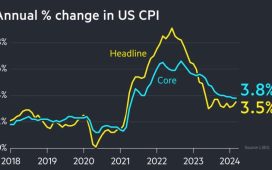How did the US economy fare in the fourth quarter of 2022?
The US economy is expected to have expanded in the fourth quarter, albeit at a slower pace than earlier in the year, as the Federal Reserve’s aggressive interest rate-raising campaign bites into growth.
The Bureau of Economic Analysis on Thursday is forecast to report that US gross domestic product grew by 2.6 per cent in the three months to December 31, according to a Bloomberg poll of economists. That would mark a shift lower from the 3.2 per cent in the third quarter.
The housing sector is likely to have contributed to that slowdown, Citi analysts Veronica Clark and Andrew Hollenhorst argue. Lower residential investment, they say, is likely to have weighed “substantially” on Q4 GDP, which is already evident in data such as housing starts and building permits. As the Fed has raised interest rates, and in turn lifted mortgage rates, the housing sector has slowed, with new home construction falling in December for the fourth consecutive month and marking the first annual drop since 2009.
Also included in the GDP release will be the personal consumption expenditures price index, which reflects changes in the price of goods and services. That data is expected to show an increase of 1.7 per cent, down from 2.3 per cent in the previous quarter. Kate Duguid
Will confidence in the European economic outlook rise?
The first economic indicators for the eurozone and the UK in 2023 are expected to show signs among companies that a downturn in Europe will be milder than previously feared.
The closely watched S&P purchasing managers’ indices, a measure of the health of private sector activity, are expected to have edged up when preliminary figures for January are published on Tuesday.
Economists polled by Reuters forecast the eurozone composite PMI index to have increased to 49.8 in January from 49.3 estimated in the previous month.
The services sector is forecast to have moved back above the 50 mark, indicating a majority of businesses reporting an expansion compared with the previous month. The manufacturing PMI is forecast to remain below that threshold, but rise to 48.5 in January from 47.8 in December.
“Aided by substantial government intervention to limit the hit to consumers and businesses from higher energy prices, activity has seemingly held up better than many had expected, to the point that recession fears for this winter have receded,” said Sandra Horsfield, economist at Investec.
While Horsfield is “cautious” about calling off a recession in the eurozone, she noted that marked falls in wholesale energy costs, aided by unusually mild weather conditions in late 2022, “may well have improved activity further in January, even though energy costs are still at high levels historically”.
Similar improvements are expected for the UK PMI indices, with the composite indicator forecast to rise near the 50 mark from 49 in December, in part thanks to the government’s energy support schemes for households and businesses supporting demand. Despite the expected improvement, most analysts forecast the British economy to be in recession for most of this year. Valentina Romei
What will tech sector earnings reveal about the Fed’s rate-tightening campaign?
The biggest names in the technology sector report earnings this week with investors keen to find out how the industry has coped with rising inflation and the Federal Reserve’s steep interest rate increases in 2022.
“The more growth oriented sectors, such as technology, have faced the biggest pressure from rising interest rates,” said Mobeen Tahir, director of macroeconomic research and tactical solutions at WisdomTree Europe.
Results from Morgan Stanley and Goldman Sachs last week exemplified the challenging environment, as a fall in M&A activity, new stock market listings and debt deals led to a massive drop in profits in the banking sector compared with the record levels seen in 2021.
Morgan Stanley’s revenues from its wealth management division in the final quarter helped it punch through analysts’ estimates with net earnings of $2.2bn but rival Goldman undershot forecasts with $1.3bn in the same period.
The outlook for tech is set to be equally divided. Microsoft, which publishes results on Tuesday, saw its share price fall about 28 per cent last year and last week announced it would be cutting 10,000 jobs to trim costs.
Shares in Tesla, which releases results on Wednesday, fell 65 per cent over the period — despite the fact its global sales volumes rose 40 per cent in 2022. Earlier this month, Tesla announced it would be cutting the price of its electric vehicles in an effort to support demand during the economic downturn forecast for this year.
“[Large investors] gave them money in the hopes that a percentage of them would make money, because money was free,” said Steve Blitz, chief US economist at TS Lombard. “Now that it’s not free anymore, money has been pulled from the potential unicorns unless they can show their profit potential.”
FactSet, the data provider, estimates that the US information technology sector had a 9.8 per cent decline in earnings per share in the fourth quarter compared to the same period a year ago.
“In the near term there are still pressures that could translate into an earnings slowdown, but as we begin to see inflation numbers coming down and pressure from central bank tightening easing, we may also see those pressures start to ease,” said Tahir. “We’re cautiously optimistic that we may pass through the policy tightening storm without a huge effect on earnings.” Martha Muir













